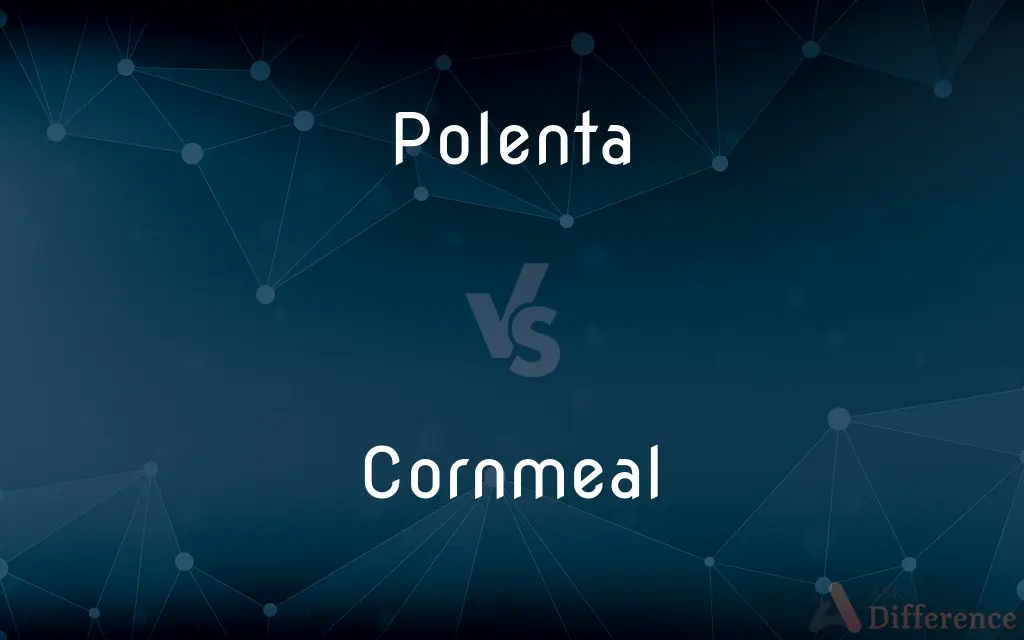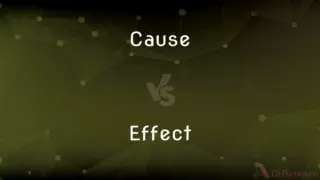Polenta vs. Cornmeal — What's the Difference?
By Tayyaba Rehman & Urooj Arif — Updated on April 16, 2024
Polenta is a dish made from boiling cornmeal into a porridge, often enriched with butter and cheese, while cornmeal is simply the dry ground corn used in various culinary applications.

Difference Between Polenta and Cornmeal
Table of Contents
ADVERTISEMENT
Key Differences
Polenta, originating from Italy, is typically made from yellow cornmeal, resulting in a creamy texture when cooked. On the other hand, cornmeal refers to the product obtained by grinding dried corn kernels, which can be either white or yellow and is used not just for making polenta but also for baking and frying.
Polenta is cooked with water or stock until it becomes thick and creamy, often enhanced with ingredients like cheese, butter, or herbs. Cornmeal, however, is versatile and used as a base for batters, breads, and as a thickener in various recipes, showcasing its adaptability in both sweet and savory dishes.
In the culinary context, polenta is considered a comfort food in many parts of the world, especially in Italian cuisine. Cornmeal, while it is the main ingredient in polenta, is also crucial in making cornbread, muffins, and coatings for fried foods, thus highlighting its broader use in diverse culinary traditions.
Nutritional profiles of polenta and cornmeal are quite similar since both are made from corn; however, the final nutritional value of polenta can vary with added ingredients like cheese and butter. Whereas, cornmeal itself is low in fat and high in fiber, making it a healthy ingredient in many diets.
The preparation time and methods also distinguish these two. Polenta requires slow cooking and constant stirring to reach the right consistency, which might take up to 45 minutes. Cornmeal can be quickly utilized in recipes like pancakes or cornbread without the extensive cooking time required for polenta.
ADVERTISEMENT
Comparison Chart
Definition
A dish made by boiling cornmeal to a porridge consistency.
Ground dried corn, used in various cooking applications.
Origin
Italian cuisine.
Used globally, varies by region.
Cooking Time
Requires prolonged cooking (around 45 minutes).
Varies, generally quick to use in recipes.
Common Uses
Served as a creamy porridge or cooled and solidified.
Used in baking, frying, and as a thickener.
Texture When Cooked
Creamy and smooth.
Depends on the recipe; can be coarse or fine.
Compare with Definitions
Polenta
A versatile base for various toppings like cheese, meats, or vegetables.
He topped the creamy polenta with braised mushrooms and onions.
Cornmeal
Ground dried corn, ranging from fine to coarse texture.
I used fine cornmeal to make a soft, tender cornbread.
Polenta
A traditional Italian dish made from cornmeal.
For dinner, we had polenta served with a rich tomato sauce.
Cornmeal
Integral in recipes like cornbread, muffins, and coatings for fried foods.
She mixed cornmeal with flour to prepare the coating for fried chicken.
Polenta
Often served creamy or allowed to solidify and then grilled or fried.
She sliced the solidified polenta and grilled it until golden.
Cornmeal
A staple ingredient in many traditional American Southern dishes.
Cornmeal is essential for authentic Southern-style grits.
Polenta
Can be made from different types of cornmeal, influencing texture and flavor.
The polenta made from fine cornmeal was exceptionally smooth.
Cornmeal
Used as a thickening agent in soups and stews.
He sprinkled some cornmeal to thicken the stew.
Polenta
Associated with comfort food in many cultures, especially in Northern Italy.
Polenta is often consumed as comfort food during the cold months in Italy.
Cornmeal
Can be made from either yellow or white corn.
The cornbread made from white cornmeal had a lighter color.
Polenta
Polenta (, Italian: [poˈlɛnta]) is a dish of boiled cornmeal that was historically made from other grains. It may be served as a hot porridge, or it may be allowed to cool and solidify into a loaf that can be baked, fried, or grilled.
Cornmeal
Cornmeal is a meal (coarse flour) ground from dried corn. It is a common staple food, and is ground to coarse, medium, and fine consistencies, but not as fine as wheat flour.
Polenta
Maize flour as used in Italian cooking; cornmeal
Maize is used, more coarsely ground, in Italy's versatile polenta
Cornmeal
Meal made from corn, used in a wide variety of foods. Also called Indian meal.
Polenta
A thick mush made of boiled cornmeal.
Cornmeal
Dried corn (maize) milled (ground) to a coarse meal.
She made a kind of polenta from cornmeal and chicken broth, with some cheese sprinkled on top.
Polenta
Any of various types and consistencies of a starchy accompaniment to a meal made from coarse maize-meal porridge, sometimes fried or grilled.
Cornmeal
Coarsely ground corn
Polenta
Pudding made of Indian meal; also, porridge made of chestnut meal.
Polenta
A thick mush made of cornmeal boiled in stock or water
Common Curiosities
Can polenta be made from any type of cornmeal?
Yes, polenta can be made from any type of cornmeal, although the texture and flavor might vary.
What are some common dishes made from cornmeal other than polenta?
Common dishes include cornbread, muffins, and as a coating for fried foods.
Can I substitute cornmeal for polenta in recipes?
Yes, cornmeal can be used to make polenta, but direct substitution in recipes depends on the desired texture and cooking method, as polenta typically refers to the cooked dish rather than just the ingredient.
How long does it take to cook polenta?
Cooking polenta usually takes about 45 minutes and requires frequent stirring to achieve a creamy texture.
What types of cornmeal are best for making polenta?
For making polenta, medium or coarse-ground cornmeal is typically preferred for its texture, though fine cornmeal can be used for a smoother consistency.
How should I store cornmeal and cooked polenta?
Cornmeal should be stored in a cool, dry place and can be kept longer if stored in the refrigerator. Cooked polenta should be refrigerated and is best used within a few days.
Are there cultural or regional variations in how polenta and cornmeal are used?
Yes, polenta is especially popular in Italian cuisine and parts of Eastern Europe, often served as a staple dish. Cornmeal is widely used in American Southern cooking, as well as in African, Mexican, and Caribbean cuisines, showing its versatility in various culinary traditions.
What is the main difference between polenta and cornmeal?
Polenta is a dish made by cooking cornmeal into a porridge, often enriched with other ingredients, while cornmeal is just the dry grain product.
Is there a nutritional difference between polenta and cornmeal?
Nutritionally, polenta and cornmeal are very similar, as both are derived from corn. However, the nutritional value of polenta can vary based on added ingredients like butter or cheese.
Is cornmeal only used for making polenta?
No, cornmeal is also used in baking, frying, and as a thickening agent in various recipes.
Share Your Discovery

Previous Comparison
Cause vs. Effect
Next Comparison
Hint vs. SuggestAuthor Spotlight
Written by
Tayyaba RehmanTayyaba Rehman is a distinguished writer, currently serving as a primary contributor to askdifference.com. As a researcher in semantics and etymology, Tayyaba's passion for the complexity of languages and their distinctions has found a perfect home on the platform. Tayyaba delves into the intricacies of language, distinguishing between commonly confused words and phrases, thereby providing clarity for readers worldwide.
Co-written by
Urooj ArifUrooj is a skilled content writer at Ask Difference, known for her exceptional ability to simplify complex topics into engaging and informative content. With a passion for research and a flair for clear, concise writing, she consistently delivers articles that resonate with our diverse audience.















































